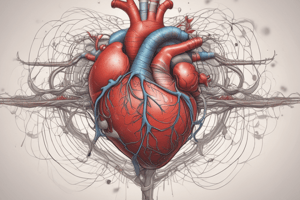Podcast
Questions and Answers
Where does oxygen-rich blood from the lungs enter the heart?
Where does oxygen-rich blood from the lungs enter the heart?
- Right ventricle
- Left ventricle
- Right atrium
- Left atrium (correct)
What is the main function of the valves in the heart?
What is the main function of the valves in the heart?
- To oxygenate the blood
- To ensure blood does not flow backwards (correct)
- To pump blood to the body
- To regulate heart rate
Which chamber of the heart has thicker muscular walls?
Which chamber of the heart has thicker muscular walls?
- Right ventricle
- Left ventricle (correct)
- Left atrium
- Right atrium
Where does de-oxygenated blood from the body enter the heart?
Where does de-oxygenated blood from the body enter the heart?
What happens when the right atrium contracts?
What happens when the right atrium contracts?
What is the main reason for the separation of the right and left sides of the heart?
What is the main reason for the separation of the right and left sides of the heart?
Why do animals like birds and mammals have a highly efficient oxygen supply system?
Why do animals like birds and mammals have a highly efficient oxygen supply system?
What is the purpose of the left atrium's contraction?
What is the purpose of the left atrium's contraction?
What is true about the heart's size?
What is true about the heart's size?
Why do ventricles have thicker muscular walls than atria?
Why do ventricles have thicker muscular walls than atria?
What happens when the left ventricle contracts?
What happens when the left ventricle contracts?
What is the function of the right ventricle?
What is the function of the right ventricle?
What is the result of the separation of oxygen-rich and de-oxygenated blood in the heart?
What is the result of the separation of oxygen-rich and de-oxygenated blood in the heart?
Flashcards are hidden until you start studying
Study Notes
Blood Flow Through the Heart
- Oxygen-rich blood from the lungs enters the thin-walled left atrium, the upper chamber of the heart.
- The left atrium relaxes while collecting blood, then contracts to transfer blood to the left ventricle.
- The left ventricle relaxes to receive blood from the left atrium, then contracts to pump oxygen-rich blood out to the body.
Deoxygenated Blood Flow
- Deoxygenated blood from the body enters the right atrium, the upper chamber on the right, as it relaxes.
- The right atrium contracts to transfer blood to the right ventricle, which dilates to receive it.
- The right ventricle then pumps the deoxygenated blood to the lungs for oxygenation.
Heart Chamber Structure
- Ventricles have thicker muscular walls than atria because they need to pump blood into various organs.
- Valves in the heart ensure that blood does not flow backwards when atria or ventricles contract.
Heart Structure and Function
- The heart is a muscular organ, approximately the size of a fist.
- It has different chambers to prevent the mixing of oxygen-rich and carbon dioxide-rich blood.
Blood Flow Through the Heart
- Oxygen-rich blood from the lungs enters the left atrium, a thin-walled upper chamber.
- The left atrium relaxes while collecting blood, then contracts to transfer blood to the left ventricle.
- The left ventricle contracts to pump blood to the rest of the body.
- De-oxygenated blood from the body enters the right atrium, another thin-walled upper chamber.
- The right atrium contracts to transfer blood to the right ventricle.
- The right ventricle pumps blood to the lungs for oxygenation.
Comparison of Heart Structures in Different Animals
- In animals with high energy needs, such as birds and mammals, the heart has a four-chambered structure to keep oxygenated and de-oxygenated blood separate.
- This separation allows for a highly efficient supply of oxygen to the body.
- In animals that do not use energy to maintain body temperature, such as amphibians and reptiles, the heart has a three-chambered structure, allowing for some mixing of blood streams.
- Fishes have a two-chambered heart, with blood being pumped to the gills for oxygenation before passing to the rest of the body.
Circulation Process
- In fish, blood goes through the heart only once during each cycle of passage through the body.
- In other vertebrates, blood goes through the heart twice during each cycle, known as double circulation.
Studying That Suits You
Use AI to generate personalized quizzes and flashcards to suit your learning preferences.



